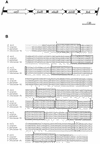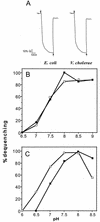Roles of NhaA, NhaB, and NhaD Na+/H+ antiporters in survival of Vibrio cholerae in a saline environment
- PMID: 12562793
- PMCID: PMC142861
- DOI: 10.1128/JB.185.4.1236-1244.2003
Roles of NhaA, NhaB, and NhaD Na+/H+ antiporters in survival of Vibrio cholerae in a saline environment
Abstract
Vibrio cholerae, the causative agent of cholera, is a normal inhabitant of aquatic environments, where it survives in a wide range of conditions of pH and salinity. In this work, we investigated the role of three Na+/H+ antiporters on the survival of V. cholerae in a saline environment. We have previously cloned the Vc-nhaA gene encoding the V. cholerae homolog of Escherichia coli. Here we identified two additional antiporter genes, designated Vc-nhaB and Vc-nhaD, encoding two putative proteins of 530 and 477 residues, respectively, highly homologous to the respective antiporters of Vibrio species and E. coli. We showed that both Vc-NhaA and Vc-NhaB confer Na+ resistance and that Vc-NhaA displays an antiport activity in E. coli, which is similar in magnitude, kinetic parameters, and pH regulation to that of E. coli NhaA. To determine the roles of the Na+/H+ antiporters in V. cholerae, we constructed nhaA, nhaB, and nhaD mutants (single, double, and triple mutants). In contrast to E. coli, the inactivation of the three putative antiporter genes (Vc-nhaABD) in V. cholerae did not alter the bacterial exponential growth in the presence of high Na+ concentrations and had only a slight effect in the stationary phase. In contrast, a pronounced and similar Li+-sensitive phenotype was found with all mutants lacking Vc-nhaA during the exponential phase of growth and also with the triple mutant in the stationary phase of growth. By using 2-n-nonyl-4-hydroxyquinoline N-oxide, a specific inhibitor of the electron-transport-linked Na+ pump NADH-quinone oxidoreductase (NQR), we determined that in the absence of NQR activity, the Vc-NhaA Na+/H+ antiporter activity becomes essential for the resistance of V. cholerae to Na+ at alkaline pH. Since the ion pump NQR is Na+ specific, we suggest that its activity masks the Na+/H+ but not the Li+/H+ antiporter activities. Our results indicate that the Na+ resistance of the human pathogen V. cholerae requires a complex molecular system involving multiple antiporters and the NQR pump.
Figures



Similar articles
-
NhaA, an Na(+)/H(+) antiporter involved in environmental survival of Vibrio cholerae.J Bacteriol. 2000 May;182(10):2937-44. doi: 10.1128/JB.182.10.2937-2944.2000. J Bacteriol. 2000. PMID: 10781565 Free PMC article.
-
Functional analysis of conserved polar residues in Vc-NhaD, Na+/H+ antiporter of Vibrio cholerae.J Biol Chem. 2005 Nov 25;280(47):39637-43. doi: 10.1074/jbc.M509328200. Epub 2005 Sep 26. J Biol Chem. 2005. PMID: 16186100
-
Cloning, functional expression in Escherichia coli and primary characterization of a new Na+/H+ antiporter, NhaD, of Vibrio cholerae.Mol Cell Biochem. 2002 Jan;229(1-2):119-24. doi: 10.1023/a:1017932829927. Mol Cell Biochem. 2002. PMID: 11936836
-
Molecular physiology of the Na+/H+ antiporter in Escherichia coli.J Exp Biol. 1994 Nov;196:443-56. doi: 10.1242/jeb.196.1.443. J Exp Biol. 1994. PMID: 7823039 Review.
-
Na(+)/H(+) antiporters.Biochim Biophys Acta. 2001 May 1;1505(1):144-57. doi: 10.1016/s0005-2728(00)00284-x. Biochim Biophys Acta. 2001. PMID: 11248196 Review.
Cited by
-
Global transcriptome analysis of Mesorhizobium alhagi CCNWXJ12-2 under salt stress.BMC Microbiol. 2014 Dec 24;14:1. doi: 10.1186/s12866-014-0319-y. BMC Microbiol. 2014. PMID: 25539655 Free PMC article.
-
Genomic Insights Into the Acid Adaptation of Novel Methanotrophs Enriched From Acidic Forest Soils.Front Microbiol. 2018 Aug 27;9:1982. doi: 10.3389/fmicb.2018.01982. eCollection 2018. Front Microbiol. 2018. PMID: 30210468 Free PMC article.
-
A UPF0118 family protein with uncharacterized function from the moderate halophile Halobacillus andaensis represents a novel class of Na+(Li+)/H+ antiporter.Sci Rep. 2017 Apr 4;7:45936. doi: 10.1038/srep45936. Sci Rep. 2017. PMID: 28374790 Free PMC article.
-
Characterization of all RND-type multidrug efflux transporters in Vibrio parahaemolyticus.Microbiologyopen. 2013 Oct;2(5):725-42. doi: 10.1002/mbo3.100. Epub 2013 Jul 27. Microbiologyopen. 2013. PMID: 23894076 Free PMC article.
-
Aeromonas sobria Serine Protease Degrades Several Protein Components of Tight Junctions and Assists Bacterial Translocation Across the T84 Monolayer.Front Cell Infect Microbiol. 2022 Feb 22;12:824547. doi: 10.3389/fcimb.2022.824547. eCollection 2022. Front Cell Infect Microbiol. 2022. PMID: 35273923 Free PMC article.
References
-
- Barua, D., and M. Merson. 1992. Prevention and control of cholera, p. 329-349. In D. Barua and W. B. Greenough III (ed.), Cholera. Plenum Medical Book Co., New York, N.Y.
-
- Berche, P., C. Poyart, E. Abachin, H. Lelievre, J. Vandepitte, A. Dodin, and J. M. Fournier. 1994. The novel epidemic strain O139 is closely related to the pandemic strain O1 of Vibrio cholerae. J. Infect. Dis. 170:701-704. - PubMed
-
- Brau, B., U. Pilz, and W. Piepersberg. 1984. Genes for gentamicin-(3)-N-acetyltransferases III and IV. I. Nucleotide sequence of the AAC(3)-IV gene and possible involvement of an IS140 element in its expression. Mol. Gen. Genet. 193:179-187. - PubMed
-
- Colwell, R. R. 1996. Global climate and infectious disease: the cholera paradigm. Science 274:2025-2031. - PubMed
-
- Colwell, R. R., and A. Huq. 1994. Vibrios in the environment: viable but nonculturable Vibrio cholerae, p. 117-133. In I. K. Wachsmuth, P. A. Blake, and O. Olsvik (ed.), Vibrio cholerae and cholera: molecular to global perspectives. ASM Press, Washington, D.C.
Publication types
MeSH terms
Substances
Associated data
- Actions
LinkOut - more resources
Full Text Sources
Molecular Biology Databases

